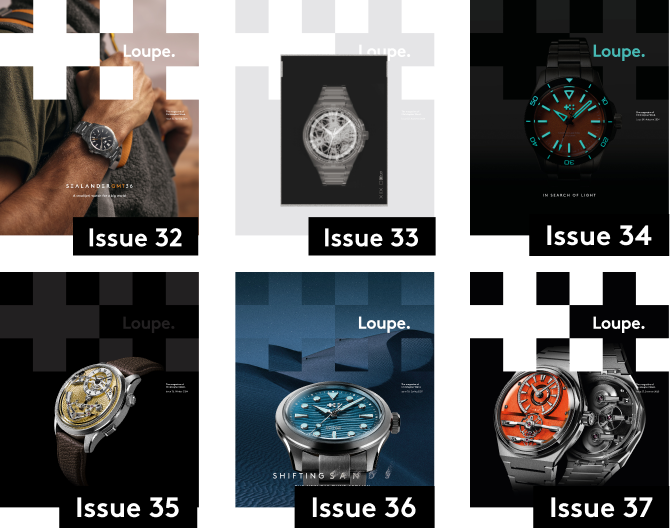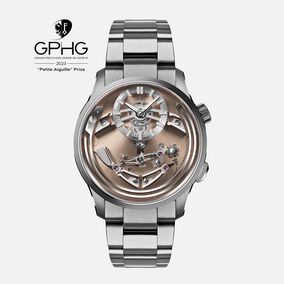Creating the Bel Canto’s chime was a long and difficult process, but one that after much experimentation delivered the perfect note
Okay, maybe ‘furore’ is over-egging it. But there was certainly plenty of head-scratching, quite a lot of sleepless nights, endless painstaking checking and re-checking, and perhaps even a sharp word or two during the development of Bel Canto’s unique (and uniquely pleasing) sound.
Watches are inherently small things, even the chunkiest of them. That’s part of the joy of them, of course – all these tiny moving parts working in harmony, a perfectly constructed refugee from the past, utilising technology obsolete in any other sphere, that records your progression into the future. A machine that’s more than a machine; that feels almost alive. And when you add complications, this only becomes more true. But though chronographs and moon phases and the rest are amazing, covetable things, nothing feels quite as alive as a chiming watch; a watch that actually speaks to you.
There are some very specific additional challenges to be overcome when creating one of these, of course – not least, how do you use the very small amounts of available real estate (tiny hammer, minuscule chime, only slightly larger case to reverberate with it all) to make a genuinely pleasing sound? “One of the first choices you have to make is a simple one,” says Frank Stelzer, the man who really drove this project. “What’s going to actually make the noise? There are two basic options: a chime spring, or a good old-fashioned bell. The first offers the clear advantage of ease of evaluation, as its shape, materials, and geometry can be quickly and easily modified again and again until you get one that sounds just right. A bell, however, can produce a more beautiful sound with better reverberation.”

So, which to pick? Well, if you were really aiming for the best possible sound, a bell would seem the way to go. But there are problems. Time and again, in fact, they’ve proven themselves essentially unsuited for use in wristwatches, being both too big and totally the wrong shape to fit into any watch case with reasonable dimensions. And they’re also highly vulnerable, the slightest damage changing the way they sound entirely. Plus, they’re hard to secure adequately within the watch. Even making them in the first place is prohibitively expensive, thanks to the high costs associated with the deep-drawing process (basically, the way we turn sheet metal into `cup-like objects).
Which leaves us, for numerous unavoidable practical reasons, with the more compact, secure (and cheaper) chime spring. But even here, there are many questions to answer. Naturally, if what we’re trying to achieve is maximum reverberation, then the longer this is, the better. Too long, however, and it will inevitably produce deeper tones than you’re probably looking for. And whatever its length, your chime spring needs to be stable enough to avoid contact with other components any time your watch gets bounced around a bit. Finding the right balance for the spring's characteristics is crucial. One that’s too strong or stable would be difficult to vibrate, giving a weedy sound. Meanwhile, the hammer that strikes it needs enough mass to effectively vibrate the spring, while being light enough to trigger it in any position in the watch.

“In fact, deciding what we were going to make the hammer from became a key decision in the creation of Bel Canto,” Frank says. “It needed to be hard enough that it would be easy to finish, just as the spring's material needed to be as hard as possible. But go too hard and you risk distorting the material, potentially even rendering the spring less than perfectly flat. The harder the material, the trickier it is to straighten or reshape it without breaking the thing.”
For the housing material, grade 5 titanium soon emerged as the most suitable option. It’s very hard, and transmits vibrations effectively, optimising the sound level. But to make it louder yet, the watch case needed to be as thin-walled as possible, while still being strong enough to absorb all the wear and tear of life. To minimise any loss of vibrations, and so make the sound as loud as possible, the sound spring was connected directly to the case.
“As with so many aspects of watchmaking, you’re constantly making trade-offs, in this case between ease of evaluation, sound quality, durability, and cost,” says Frank. “Choosing between a chime spring and a bell brought all these factors into play, although – ultimately – a chime spring was by far the most practical choice.
So, what about the particular one used in Bel Canto? “We experimented with all sorts of clay springs to determine the optimal parameters,” Frank says. “Different lengths, different cross-sections, different geometries, different materials, and assorted hardness levels – all were tried. (Of course, thanks to the limited size of the Bel Canto’s board, some of these were impractical from the get-go.) And, actually, we managed to narrow things down pretty quickly. Maybe 30 different basic shapes were drawn, then produced using laser technology, before each spring was individually modified at the watchmaker's table using a Dremel tool, tried, and eliminated until just one was left. In all, more than 90 different springs were made during the development phase.

At the same time, the Bern University of Applied Sciences was brought on board to help develop a sound check box, which allowed for the graphical display of frequency, sound volume and tone length, enabling a comparison between each newly produced tone and a reference tone. “This tool provided valuable insights, and aided hugely in the refinement of our spring design,” Frank says. “The impact intensity of the hammer, determined by its force and speed, played a significant role in shaping the sound too. It was crucial to get the amount of force applied for the preload just right; if too large, we got excessive amplitude loss in the base movement, which had dire implications for both timekeeping accuracy and power reserve.”
Lots of things to take into consideration, then – not all of them immediately obvious. But through it all, the key aim was to make the most efficient use possible of the limited space on the module plate, while ensuring the optimum sound quality. “The combination of experimenting with clay springs, refining the designs, and using the sound check box for objective comparisons allowed us to create a well-tuned and harmonious final spring,” Frank says.

Hold your watch in your hand, and you can hear just how pleasing the finished sound actually is: one characterised by exceptional harmonious quality and impressive audible reverberation. “In fact, we believe we’ve got very close to it being as good as it possibly could be,” Frank says.
Speak to anyone at Christopher Ward’s Biel atelier and they’ll tell you that, though “a-ha!’ moments came on the regular, the learning curve for this watch was a painfully steep one. Steep, but more than worthwhile, not just because we got Bel Canto out of it, but also because the amount of valuable know-how learned during the process is sure to prove invaluable when applied to future sound projects. Take that sound check box, for instance, the one developed in collaboration with a university in Bern. As it allows for precise measurement and graphical representation of various sound parameters, could it perhaps be used for watch certification purposes in the future?
“As with so much that’s Christopher Ward, achieving an unbeatable price-performance ratio was crucial,” Frank says. “By carefully balancing design, materials, and production processes, Bel Canto can offer an exceptional quality of sound at an almost unbelievably reasonable price. All in all, this is a remarkable watch – and one that’s been a uniquely challenging, yet rewarding, project to work on. And the implications of certain aspects of its development are almost certain to reverberate loudly over the years ahead.”
For more behind the scenes stories from Christopher Ward, visit christopherward.com/loupe
Related watches

Sign up to Loupe magazine
Loupe is Christopher Ward’s quarterly in-house magazine. If you want to know what’s happening at CW (and you love great journalism), this is where to start. Alternatively, you can read all our back issues on your computer, tablet or phone.
Order your free copyRead Loupe online





